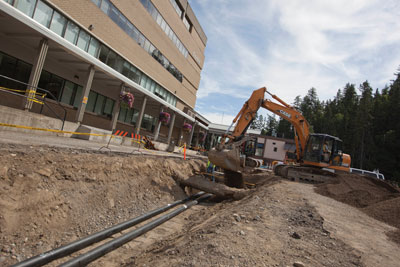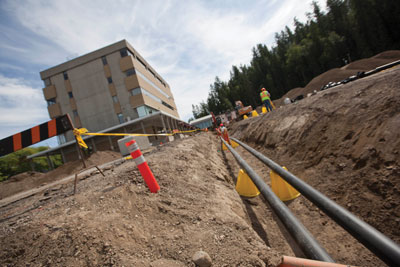
Spreading the Warmth
October 31, 2011
By Treena Hein
District heating is suddenly hot in western Canada. “Similar, yet different” is a good way to sum up the new projects in Prince George and Quesnel, British Columbia, and Strathcona, Alberta.
District heating is suddenly hot in western Canada. “Similar, yet different” is a good way to sum up the new projects in Prince George and Quesnel, British Columbia, and Strathcona, Alberta. While the end goal and system basics are the same—a connected group of buildings heated using biomass-based energy—the details, journey, and challenges are more diverse.
 |
|
| Hot water distribution pipes for Prince George, British Columbia’s district energy project are laid down outside City Hall. Photos: Paul Alberts, City of Prince George |
Prince George on track
Construction of Prince George’s downtown district energy system (DES) got underway at the start of August 2011 and is going almost completely according to plan, says communications manager Mike Davis. Like other district heating systems, the DES involves the installation of pipes leading from the heat source to interconnected buildings. This work has been sandwiched in time between the removal and eventual reconstruction of existing road structures, curbs, gutters, and more. The DES will capture heat from a biomass-based boiler system already in place at the Sinclair Group Forest Products’ Lakeland Mills sawmill to generate heat and hot water. The equipment for the DES that’s being installed at Lakeland will be owned by the City and operated by the mill.
Wellons Canada is supplying the heat recovery system. Waste heat will be captured from the mill’s exhaust stack and will also be netted from the excess capacity of the mill’s heating system. The hot gas will pass through a heat exchanger to heat fluid in the DES pipeline. A metered exchange point at the mill will measure the energy that the City will purchase from Lakeland Mills. The heat will then pass through a hot water heating loop under the CN rail yards to the peaking/back-up plant downtown. “This will house the circulation pumps, natural gas back-up peaking boilers, and other equipment like a standby generator,” says Marco Fornari, manager of utilities for Prince George.
“From that plant, we will be connecting approximately 10 buildings.” These include the library, Civic Centre, Four Seasons, Art Gallery, Coast Inn, Coliseum, the peaking plant, and City Hall. All of these structures were previously heated by hot water heat from natural gas-fired boilers.
An electrostatic precipitator supplied by Wellons will improve the mill’s particulate emissions. Additional air quality improvements will be gained from reduced truck traffic leaving the mill to transport residue to pellet plants because more biomass will be consumed onsite for heat generation. “This reduction in particulate emissions was a very important factor in public acceptance and support of the project,” says Fornari.
Strathcona’s diverse fuels
Ground has also been broken for a district heating system in Strathcona County, Alberta, at Sherwood Park’s Centre in the Park. It will keep nine buildings cosy when complete: three municipal office buildings, a community theatre, ice arena, swimming pool, and three condos. The made-to-order heating module is being built by Lambion Energy of Germany and will arrive in mid-September 2011. Two additional fuel containers will allow for three-plus days of fuel storage.
 |
|
| Pipe work in Prince George has been timed around road repair work.
|
“The equipment is being custom designed to accommodate local feedstocks,” says Norm Swonek, project manager of community energy systems for Strathcona County. “These include waste wood (pallets) from the commercial sector, agricultural residues such as straw from farmers, and oat hulls from Alberta Oats.”
In addition, the system will accept wood pellets made by a local company using a Doppstadt wood grinder and a pelletizer from New Brunswick-based Pellet Systems International. The use of different fuels will be computer-controlled. “Each fuel…is programmed into the system, and when the fuel switches, the module will automatically adjust,” Swonek explains. About 250 kilograms/hour of fuel and 1400 tonnes for the entire heating season (October to April) is expected to be required.
A $1.5 million grant for the system from the Western Economic Diversification Program went to both the Resource Industry Suppliers Association and Strathcona County. They each are also contributing $675,000 to the project. When cost-return will be achieved is a matter of how current energy prices play out. “[Because] the system uses local fuels to offset natural gas, at the present cost of natural gas, the cost-return will have a much longer payback period than if the cost of natural gas were higher,” Swonek says.
Quesnel’s unique system
The City of Quesnel in British Columbia and Terasen Gas are moving forward on a final feasibility study of a proposed unique combined heat and power (CHP)/district heating system, in cooperation with West Fraser Timber Co. Ltd. and BC Hydro. “The Quesnel Community Energy System (QCES) is currently in a negotiation stage, and we are awaiting a number of final details before moving into a new round of assessment on costs,” says Quesnel economic development officer April Cheng. “With the successful conclusion of. . .agreements and the engineering work, approval from the BC Utilities Commission will be required to proceed with the project. We are unsure, at this time, if the project will be operational in 2012.”
The plan is for both waste heat and residues from West Fraser’s Quesnel sawmill to be used to generate heat and electricity, a first in North America. The QCES is expected to provide 5.5 MW of heat to 22 industrial, municipal, commercial, and multi-dwelling residential buildings, as well as up to 1.7 MW of electricity, to be purchased by BC Hydro. About 40% of all energy used in the system will be from recovered waste heat, with an overall planned energy efficiency of 90%. An estimated 9,000 tonnes/year of wood waste from milling operations will be burned.
Cheng says the partners are continuing to press forward in finding funds for the project, which had an initial estimated capital cost of $14 million. Quesnel’s Economic Development Corporation secured a grant of $4.13 million through B.C.’s Innovative Clean Energy Fund, with Terasen Gas providing funds as well. Western Economic Diversification Canada, the Green Municipal Fund, BC Hydro, and BC Bioenergy Network are also involved.
Advice, please
Who better to ask for advice and insights into how to handle challenges in navigating a district heating project than those on the front line? Swonek says the list of challenges in Strathcona included funding, selection of the best available technology, securing local sustainable feedstocks, and transportation and processing logistics. “District heating systems require large initial capital investments, which requires funding by either grants or borrowed funds,” he notes, adding, “Securing customers to deliver the energy to is key.”
Two challenges stood out in Prince George. The first was the need to overcome public misconception that bioenergy systems are high emitters of pollutants. “The emissions from modern bioenergy plants are in fact similar to emissions from natural gas boiler systems,” Davis explains. The city got this message out in the proposal stage through holding public engagement sessions; notes from these meetings were included in the mandatory Federal Environmental Assessment. This was part of an overall communications plan to share information that will continue throughout construction. The City highlighted positive aspects such as the fact that the system will be paid for in 10 years and has a positive net present value of $2.8 million over 25 years. However, at the same time, Davis says the other major challenge was how to maintain the financial viability of a biomass-based energy supply utility in the face of historically low natural gas prices. “We are effectively competing against natural gas in the market place for heat customers,” says Davis.
Although the Quesnel project is still at the stage of working out funding and other details, Cheng shares some advice, “Patience. These projects take time, and some of [our] early mistakes were on the suggested amount of time.” She also advises, “Take the figures lightly. Cost estimates and revenues can change based on any one single factor, and partners need to be prepared for change on projects of this scale and complexity.” •
Print this page